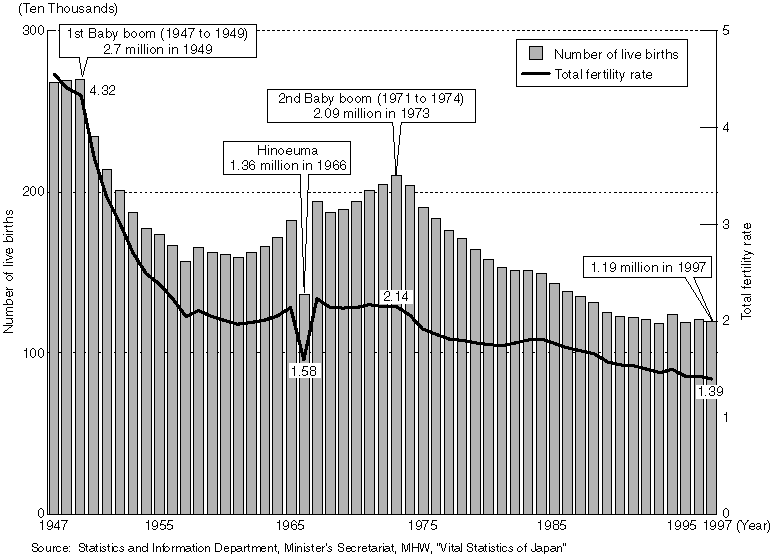
The number of elderly people has continued to increase while that of children born has been on a declining trend for the recent years in Japan. The total fertility rate (sum of the live birth rates by age for women aged 15 to 49; the number of children born to a woman over the course of her lifetime on the assumption that she delivers babies at the live birth rate by age in that year) started declining sharply in around 1950 when the first baby boom after the war was over. After going down to slightly over 2 in the mid-1950s, the rate remained mostly stable until the mid-1970s. Subsequently, it started declining again and has tended to decline up to date. The total fertility rate in 1997 was 1.39, which is far below the level necessary for maintaining the present population (population replaceable level) of 2.08.
According to a projection by the National Institute of Population and Social Security Research, the Japanese population will start declining after the peak in 2007 even if the live birth rate recovers to a certain level. It will stand at around 100 million in 2050 and 67 million in 2100, which is about half the present population. Thus, a society with decreasing population would become reality. The aging of the society will also progress rapidly and the ratio of the elderly will rise from 15.7% in 1997 to 32.3% in 2050, with people aged 65 or older accounting for about one third of total population.
Figure 5-1-1. Trends in the Number of Live Births and Total Fertility Rate

Figure 5-1-2. Estimated Total Population of Japan
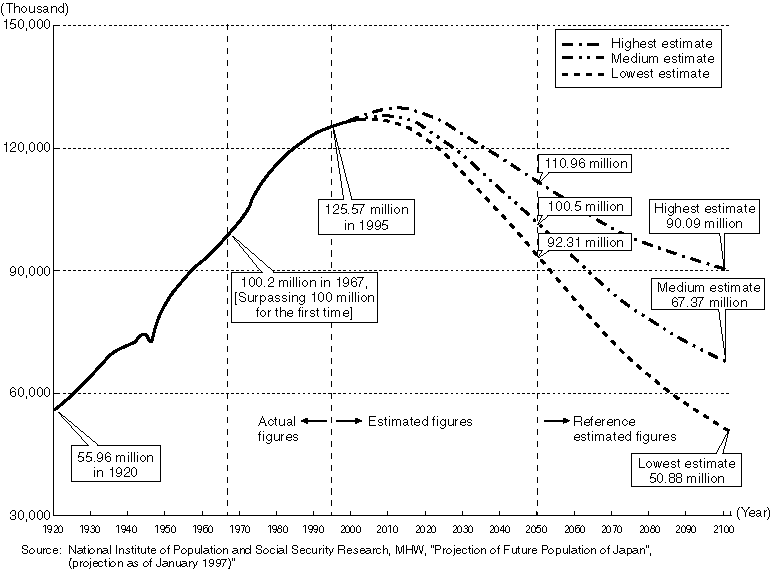
2. Social and Economic Effects of a Decrease in the Number of Children
A decrease in the number of children is expected to affect the society and the economy at large.
In the economy, it will result in decreased labor force population as well as smaller supply of labor force in terms of real working hours due to the aging of labor force population, which might impede the economic growth. At the same time, it will increase the burden upon generations in active service with regard to social security including pensions, medical treatment and welfare.
As for social influence, it is feared that a decrease in the number of children might have negative impacts upon sound growth of children, decreasing opportunities for children to develop sociality. At the same time, depopulation and aging will progress in a variety of regions. Consequently, it might become difficult to provide the residents with fundamental services, e.g. welfare services, and to operate medical insurance systems.
3. Factors and Background behind a Decrease in the Number of Children
The major cause for the recent decrease in the number of children is a further increase in later marriages. The average number of live births per married couple has basically remained at around 2.2 for the last twenty years, but the ratio of men and women who get married young has declined sharply. In addition, children born to unmarried couples are much fewer compared with the Western nations. These factors have contributed to a decline in the overall average live birth rate.
Factors behind the progress of later marriages include an inflexible idea about the division of roles between men and women ?"men should work outside and women should take care of family affairs"? and differentials between men and women in treatments at work sites, which is based upon the idea that "key jobs are for men and supplementary jobs are for women". Corporate culture to give priority to corporate affairs is also an important factor. Such circumstances have made women feel more burden about child care as well as about the reconciliation between their jobs and child care. At the same time, ideas about marriage as well as values of individuals have changed. For example, women now feel smaller necessity for getting married for their living because the economic power of women has improved.
Figure 5-1-3. Changes in the Ratio of the Never Married by Age
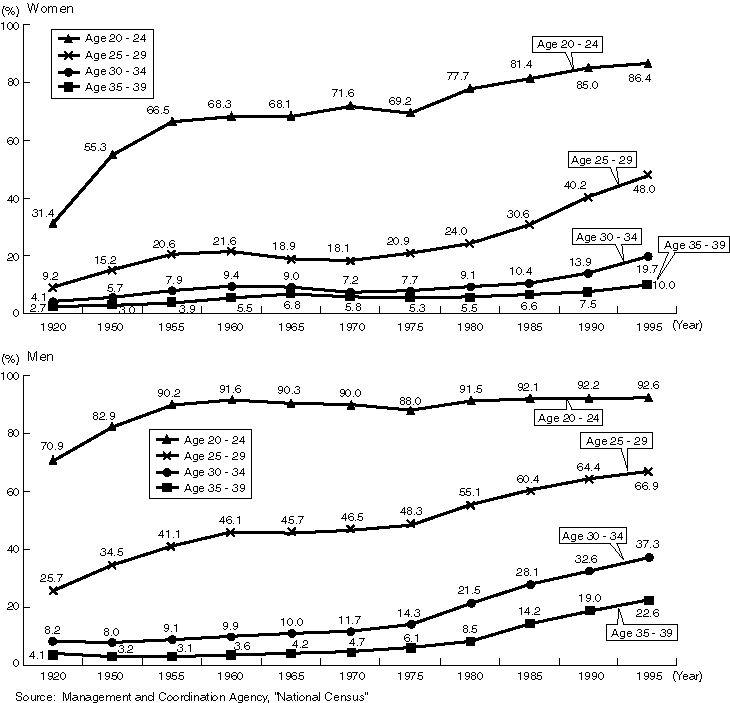
According to a research on ideas about marriage, however, about 86% of men and around 89% of women "intend to marry sooner or later". This suggests that most of the Japanese people hope to get married, although the ratio of such people is declining.
In the meantime, the actual number of children born to a couple is smaller than the ideal number of children. These facts suggest that Japan is under socioeconomic and psychological restrictions that impede marriage, delivery, and child rearing. Such restrictions must be eliminated through efforts by the society as a whole.
Table 5-1-4. Intention of Marriage in Future of the Never Married in Each Research

Figure 5-1-5. Changes in the Average Number of Children Born to a Couple and the Average IdealNumber of Children
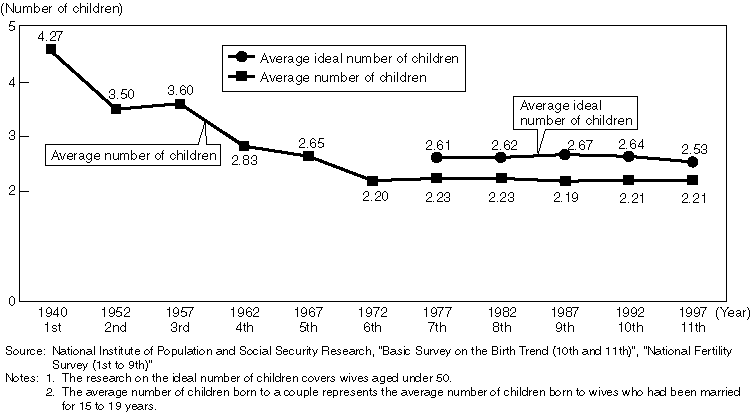
Figure 5-1-6. Reasons Why Women Do Not Have Their Ideal Number of Children (1997)
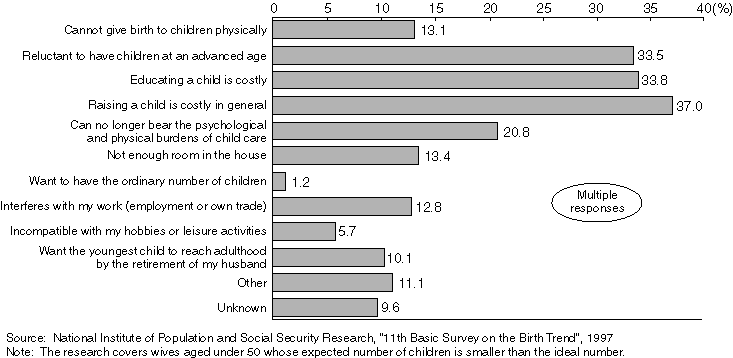
4. Past Measures to Cope with Fewer Number of Children
(1) Presentation of problems in report by the Council of Population Problems and Annual Report on Health and Welfare
Thus, the number of children is decreasing while a society with decreasing population is to be realized soon. Under such circumstances, the Council on Population Problems prepared a report titled "Basic Ideas on a Decrease in the Number of Children" in September 1997, which is based upon opinion of learned people in various circles and discussions at meetings of municipal and prefectural residents that had been held since February 1997. The report, which directly addressed the problem of fewer children for the first time as a governmental council, made comprehensive analyses of impacts, factors and background of a decrease in the number of children. At the same time, it clarified the necessity of measures to cope with fewer children. "It is finally a responsibility, as well as choice, of nationals to decide how we should consider the problem of fewer children and a society with decreasing population and how the Japanese society should be in future", says the report, encouraging discussions by the nationals as a whole.
Subsequently, Annual Report on Health and Welfare 1997 - 1998 (issued in June 1998) tried to present other problems related to a society with fewer children, based upon the report. In other words, the annual report reviewed the latter half of the 20th century when the number of children grew increasingly smaller. At the same time, it projected desirable features of families where each member supports each other respecting the lifestyle of independent individuals, communities where independent individuals support each other in solidarity, and work sites and schools that match a variety of lifestyles, hoping that public discussions will follow. Thus, it aimed to contribute to the realization of "a society where people can have dreams in delivering and rearing children".
(2) Discussions at "the Meeting of the Learned to Consider Measures to Cope with Fewer Number of Children"
The total fertility rate dropped to the historical low of 1.39 in 1997, proving an accelerated decrease in the number of children. Under such circumstances, "Meeting of the Learned to Consider Measures to Cope with Fewer Children (Meeting of the Learned)" was organized in July 1998, under the presidency of the Prime Minister. The Meeting of the Learned is supposed to present concrete proposals concerning the creation of environment where individuals can make their own decisions about marriage and delivery. At the same time, it is to function as a resource of public discussions.
The meeting consists mainly of comparatively young generations in their thirties and forties and the number of women almost equals the number of men, in order that views of people from a wide variety of categories will be reflected. The meeting has two subcommittees, namely the "Subcommittee on Working Forms," in which working form-related topics are discussed, and the "Subcommittee for Giving Dreams to Families," in which topics related to families, communities, and schools are discussed. More than half of the members of each subcommittee have been invited from the public through advertisement, which enabled people with varied jobs and experience to participate in the discussions of the meeting.
Column
Based upon the proposal by the "Meeting of the Learned to Consider Measures to Cope with Fewer Children" (December 1998), the Ministry of Health and Welfare has decided to conduct publicity and enlightenment activities to emphasize joint responsibilities of mothers and fathers in child rearing and the importance and joy of child rearing. The ministry encouraged men, who tend not to participate in child care, to be sufficiently aware of their responsibilities and insisted on the necessity of their participation in child rearing, through media such as posters, TV and newspapers (March 1999). |
The Meeting of the Learned prepared a proposal titled "For the Establishment of Society Where Nationals Can Form Families and Bring Up Children with Dreams" in December 1998, which was based upon the reports by the two subcommittees. The proposal was submitted by the chairman to the Prime Minister.
(3) Outline of proposal by the meeting of the learned
First, the proposal requires the improvement of environment to realize a society where people can cherish dreams in families and child rearing, by eliminating socioeconomic and psychological factors that have made it difficult for young men and women to create new families and experience the joy and fun of bringing up children, through efforts by the society as a whole.
Next, the proposal presents three points to be attended to, before presenting concrete proposals respectively. First of all, marriage and delivery should be left to free choices of individuals and must not be forced by the society to individuals. Second, a further decrease in the number of children during its progress will have serious impacts upon future generations both economically and socially. Third, the opinion that women should be sent back to families is unrealistic and contradictory to the idea of joint participation by men and women. Also, it is inappropriate and unreasonable to restrict working opportunities for women.
The proposal presents more than 150 individual concrete proposals in a variety of areas, which have been categorized according to the main themes towards the future. Concrete proposals include the revision of the division of roles between men and women, the correction of corporate culture giving priority to jobs, support of the reconciliation between jobs and child care such as the diversification of working forms, the promotion of joint participation by men and women in family affairs, and the improvement of child care services such as daily nurseries that are strongly needed.
It clarifies the organizations that are to lead the consideration and execution of respective proposals and encourage respective circles to make subjective efforts in their positions, in order that such proposals will be realized in the whole society. It also proposes to organize "National Convention (temporary name)" as the core body for the realization of proposals, because comprehensive, public efforts are necessary for promoting the improvement of environment, as well as to improve the system for minister-level efforts for the promotion of measures that should be led by the government.
5. Future Efforts to Cope with Fewer Number of Children
In response to the proposal by the Meeting of the Learned, the government held the first "Ministerial Conference on the Promotion of Measures to Cope with Fewer Number of Children" in May 1999 and agreed about future promotion of measures to cope with fewer number of children. The government has also decided to organize "National Convention to Promote Measures to Cope with Fewer Number of Children", inviting related people in different circles to participate, in order to promote public, comprehensive efforts.